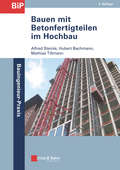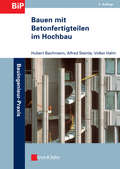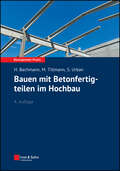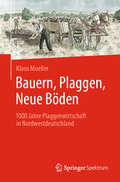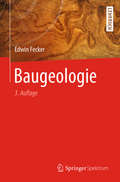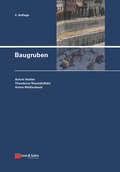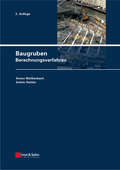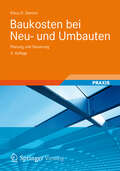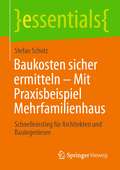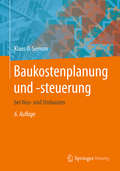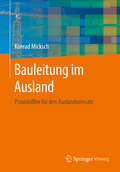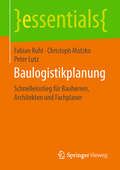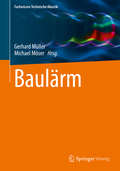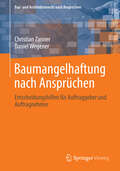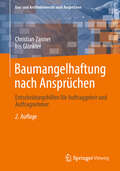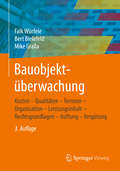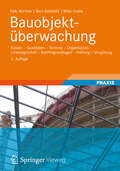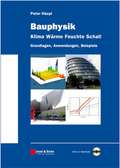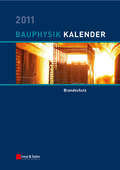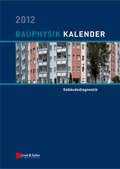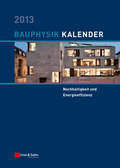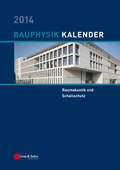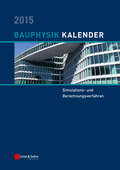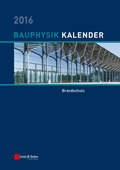- Table View
- List View
Bauen mit Betonfertigteilen im Hochbau (Bauingenieur-Praxis)
by Hubert Bachmann Alfred Steinle Mathias TillmannDer Betonfertigteilbau ist eine der innovativsten Bauweisen - hier werden neue Betone, Bewehrungen und Herstellverfahren erstmals angewendet, denn das Fertigteilwerk bietet hervorragende Voraussetzungen für die industrielle Fertigung und die Herstellung von Einzelstücken. Das vorliegende Buch führt in die Bauweise ein und vermittelt alles notwendige Wissen für die Konstruktion, Berechnung und Bemessung. Auch die geschichtliche Entwicklung und der Stand der europäischen Normung werden aufgezeigt. Der Dreh- und Angelpunkt für den wirtschaftlichen und fehlerfreien Einsatz von Betonfertigteilen und Hauptanliegen dieses Buches ist der fertigungs- und montagegerechte Entwurf. Neben den zu beachtenden Randbedingungen werden typische Fertigteilkonstruktionen zur Diskussion gestellt. Die Verbindungen der Betonfertigteile sind als Schwachstelle gerade bei Horizontallasten besonders zu beachten. Daher wird die Aussteifung von Fertigteilgebäuden ausführlich behandelt. Insbesondere aufgrund von kritischen Detailnachweisen ist eine ingenieurmäßige vereinfachende Betrachtung der Aussteifung gegenüber einer computergestützten Berechnung vorzuziehen. Besonderheiten der Bemessung, z. B. Lager, Knoten und Stöße, werden vertieft dargestellt. Ein zunehmend wichtiger Anwendungsbereich für Betonfertigteile ist der Fassadenbau, welchem ein eigenes Kapitel gewidmet ist. Hier spielt der Einsatz von neuen Betonen und Bewehrungen eine große Rolle, wie z. B. ultrahochfester Beton mit Glasfaser- oder Carboneinlagen. Abschließend wird auf die Fertigung eingegangen, um beim Leser das Verständnis für die Bauweise unter Berücksichtigung der Herstellung zu erweitern. Für die vorliegende 3. Auflage wurde das Buch vom erweiterten Autorenteam komplett überarbeitet. Das Buch ist eine Einführung und ein praktisches Arbeitsmittel mit Beispielen für Bauingenieure und Architekten gleichermaßen.
Bauen mit Betonfertigteilen im Hochbau (Bauingenieur-Praxis)
by Hubert Bachmann Volker Hahn Alfred SteinleThis book provides a comprehensive insight into precast concrete construction today. The reader learns of the many facade design options made possible by this method of building. The authors also attempt to convey to engineers and architects the range of possibilities opened up by works prefabrication, thus preparing the way for the cost-effective use of concrete precast construction and for its further development. In addition to making general observations on actual building with concrete precast sections, the authors explain exactly what is involved in designing such sections; they also give the reader an insight into load-bearing elements and facades. Reinforcing systems are dealt with, and connecting elements and specific static-constructive problems are explained in detail, as are the requirements of the European domestic market. The description of the precast concrete section manufacturing process provides the reader with the necessary understanding of the individual characteristics of this industrialized method of building.
Bauen mit Betonfertigteilen im Hochbau (Bauingenieur-Praxis)
by Hubert Bachmann Mathias Tillmann Susanne UrbanDer Betonfertigteilbau ist eine der innovativsten Bauweisen - hier werden neue Betone, Bewehrungen und Herstellverfahren erstmals angewendet, denn das Fertigteilwerk mit industrialisierten Fertigungsmethoden bietet hervorragende Voraussetzungen für die serielle Fertigung wie auch die Herstellung von Einzelstücken. Das vorliegende Buch führt in die Bauweise ein und vermittelt alles notwendige Wissen für die Konstruktion, Berechnung und Bemessung. Auch die geschichtliche Entwicklung und der Stand der europäischen Normung werden aufgezeigt. Der Dreh- und Angelpunkt für den wirtschaftlichen und fehlerfreien Einsatz von Betonfertigteilen und Hauptanliegen dieses Buches ist der fertigungs- und montagegerechte Entwurf. Neben den zu beachtenden Randbedingungen werden typische Fertigteilkonstruktionen zur Diskussion gestellt. Die Verbindungen der Betonfertigteile sind als Schwachstelle gerade bei Horizontallasten besonders zu beachten. Daher wird die Aussteifung von Fertigteilgebäuden ausführlich behandelt. Insbesondere aufgrund von kritischen Detailnachweisen ist eine ingenieurmäßige vereinfachende Betrachtung der Aussteifung gegenüber einer computergestützten Berechnung vorzuziehen. Besonderheiten der Bemessung, z. B. Lager, Knoten und Stöße, werden vertieft dargestellt. Ein zunehmend wichtiger Anwendungsbereich für Betonfertigteile ist der Fassadenbau, welchem ein eigenes Kapitel gewidmet ist. Hier spielt der Einsatz von neuen Betonen und Bewehrungen eine große Rolle, wie z. B. ultrahochfester Beton mit Glasfaser- oder Carboneinlagen. Abschließend wird auf die Fertigung eingegangen, um beim Leser das Verständnis für die Bauweise unter Berücksichtigung der Herstellung zu erweitern. Für die vorliegende 4. Auflage wurde das Buch vom erweiterten Autorenteam komplett durchgesehen und aktualisiert. Das Buch ist eine Einführung und ein praktisches Arbeitsmittel mit Beispielen für Bauingenieure und Architekten gleichermaßen.
Bauern, Plaggen, Neue Böden: 1000 Jahre Plaggenwirtschaft in Nordwestdeutschland
by Klaus MuellerDie Plaggenwirtschaft war eine über 1000 Jahre praktizierte Form der Landwirtschaft, die den gesamten nordwestdeutschen Raum in einzigartiger Weise geprägt hat. Zeugnisse dieser Landnutzung wie fruchtbare Böden, Eschkanten und ausgedehnte Heidegebiete, lassen sich bis heute in der Landschaft finden. Neben der landwirtschaftlichen Entwicklung, Bodennutzung und typischen Landschaftsformen beeinflusste sie auch ganz wesentlich das Fühlen, Denken, Handeln und Zusammenleben der Menschen dieser Zeit. Aber wer weiß heute noch etwas darüber? Das Buch gibt hierauf spannende und interessante Antworten. Vorgelegt wird eine erste allgemein verständliche Übersicht zu allen Aspekten der Plaggenwirtschaft in Nordwestdeutschland. Angesprochen werden nicht nur Landwirte, Bodenkundler, Geographen und Archäologen, sondern vor allem auch Leser, die Interesse an der bäuerlich geprägten Vergangenheit der Menschen und deren sozio-kulturelle Prägung in Niedersachsen, Nordrhein-Westfalen, Schleswig-Holstein und Teilen Mecklenburgs haben.
Baugeologie
by Edwin FeckerFür den Bauingenieur und den beratenden Ingenieurgeologen ist es unerlässlich, die Einflüsse geologischer Gegebenheiten auf die Bauplanung und -ausführung sowie auf das fertige Bauwerk richtig bewerten zu können.Dieses Buch vermittelt sowohl dem Praktiker als auch dem Studenten das dazu nötige Grundwissen der Allgemeinen Geologie, der Gefüge- und Gesteinskunde. Übersichtlich stellt es die bautechnischen Eigenschaften des Gebirges dar, wobei die Einflüsse von Berg- und Grundwasser auf das ober- oder untertägige Bauen besondere Berücksichtigung finden. Methoden zur Untersuchung von Gestein und Gebirge und zur Vermeidung von Schäden werden vorgestellt. Die aktualisierte 3. Auflage bespricht zusätzlich technische Neuerungen und weist auf die neuesten Normen und Vorschriften hin.
Baugruben: Berechnungsverfahren
by Anton Weißenbach Achim Hettler Theodoros TriantafyllidisMit der Einführung des Eurocode 7-1 "Entwurf, Berechnung und Bemessung in der Geotechnik - Teil 1: Allgemeine Regeln" einschließlich dem Nationaler Anhang und der DIN 1054: 2010-12 "Baugrund Sicherheitsnachweise im Erd- und Grundbau - Ergänzende Regeln zu DIN 1997-1" sowie den Änderungen A1: 2012 und A2: 2015-11 war eine Anpassung der 2. Auflage erforderlich geworden. Die Überarbeitung wurde dazu genutzt, die ursprüngliche Idee von Anton Weißenbach aufzugreifen, das Gebiet umfassend in vier Bänden abzuhandeln.Die Themen:- Konstruktion und Bauausführung- Berechnungsgrundlagen- Berechnungsverfahren- Baugrubenumschließung in besonderen Fällenwurden alle mit der vorliegenden 3. Auflage in einem Buch zusammengefasst. Die Berechnungsbeispiele wurden ebenfalls an das Handbuch Eurocode 7, Band 1 angepasst und erweitert um eine Baugrube mit rückverankerter Betonsohle. Das Kapitel "Bemessung der Einzelteile" sowie die Berechnungsbeispiele in Kapitel 20 wurden komplett überarbeitet.Das Buch ist ein wertvoller Ratgeber für die tägliche Praxis in der Geotechnik und im übrigen Konstruktiven Ingenieurbau.
Baugruben: Berechnungsverfahren
by Anton Weißenbach Achim HettlerThe book deals with the structural design of temporary excavation support and the dimensioning of excavation support walls and their individual components. Completely calculated examples explain the application of the procedures described in the book.
Baukosten bei Neu- und Umbauten: Planung und Steuerung
by Klaus D. SiemonKostensicherheit in der Bauplanung wird zunehmend ein wesentlicher Teil des Projekterfolgs. Das Buch enthält alle wesentlichen Informationen, die notwendig sind, Baukosten sachgemäß zu planen und erfolgreich zu steuern. Darüber hinaus erhalten Architekten und Ingenieure wertvolle Hinweise, um die Baukostensteuerung wieder als eigene Domäne der Leistungserbringung aufzubauen und damit Marktanteile aus der Projektsteuerung zurückzuerobern. Alle Informationen, die für die Kostenplanung und Kostensteuerung benötigt werden, sind in einer einmaligen kompakten und übersichtlichen Form dargestellt. Der Informationsstand berücksichtigt alle relevanten Normen bis zum Stand 2008. Die 5. Auflage berücksichtigt die Entwicklungen der DIN 276, geht auf die aktuelle Rechtsprechung ein und enthält neue Beispiele.
Baukosten sicher ermitteln – Mit Praxisbeispiel Mehrfamilienhaus: Schnelleinstieg für Architekten und Bauingenieure (essentials)
by Stefan ScholzStefan Scholz stellt in diesem essential die wesentlichen Anforderungen an die Arbeitsweise für eine sichere Kostenplanung dar. Der Leser erhält außerdem Hinweise und Tipps aus der Praxis für die sichere Kostenermittlung von Bauvorhaben. Die Arbeitsdateien und das Praxisprojekt zum Buch ermöglichen eine kurzfristige Umsetzung von Kostenplanungen des eigenen Projektes.
Baukostenplanung und -steuerung: bei Neu- und Umbauten
by Klaus D. Siemon Raphael Speckhals Anna SiemonKostensicherheit in der Bauplanung ist ein wesentlicher Teil des Projekterfolgs. Das Buch enthält alle wichtigen Informationen, die notwendig sind, Baukosten, insbesondere bei komplexen Projekten, sachgemäß zu planen und erfolgreich effektiv zu steuern. Darüber hinaus erhalten Architekten und Ingenieure sowie Bauherrn wertvolle Hinweise, um die Baukostensteuerung als integrales Kerngeschäft der Leistungserbringung aufzubauen und damit Marktanteile (z.B. Besondere Leistungen) zu besetzen. Ausführlich wird das Schnittstellenmanagement zwischen den Planungsbeteiligten untereinander, dem Auftraggeber sowie den ausführenden Firmen behandelt. Alle Informationen, die für die Kostenplanung und Kostensteuerung benötigt werden, sind in einer kompakten und übersichtlichen Form dargestellt. Eine umfassende und übersichtliche Rechtsprechungsübersicht enthält die herrschende Rechtsprechung zum Thema Baukosten und anrechenbare Kosten.Die 7. Auflage berücksichtigt die Neuregelungen aus der der DIN 276, Fassung 2018, die neue HOAI 2021 und die seit 01.01.2018 geltenden neuen Regelungen des BGB zu Architekten- und Ingenieurverträgen in praxisorientierter Form. Darüber hinaus werden die neuen Kostensteuerungsinstrumente behandelt und die inhaltliche Abgrenzung zu den Grundleistungen der HOAI aufgezeigt. Auch die neuen Bestimmungen des BGB (01.01. 2018) zu Architekten- und Ingenieurverträgen und ihren unmittelbaren Einfluss auf die Kostenplanung und Kostensteuerung werden berücksichtigt.Das Buch stellt damit eine im Tagesgeschäft wichtige Arbeitsgrundlage für Architekten, Ingenieure, Auftraggeber, Fachanwälte für Bau- und Architektenrecht dar
Baukostenplanung und -steuerung: bei Neu- und Umbauten
by Klaus D. SiemonKostensicherheit in der Bauplanung ist ein wesentlicher Teil des Projekterfolgs. Das Buch enthält alle wichtigen Informationen, die notwendig sind, Baukosten sachgemäß zu planen und erfolgreich effektiv zu steuern. Darüber hinaus erhalten Architekten und Ingenieure sowie Bauherrn wertvolle Hinweise, um die Baukostensteuerung als integrales Kerngeschäft der Leistungserbringung aufzubauen und damit Marktanteile nicht nur in der Gegenwart, sondern insbesondere in der Zukunft zu besetzen. Alle Informationen, die für die Kostenplanung und Kostensteuerung benötigt werden, sind in einer kompakten und übersichtlichen Form dargestellt. Die 6. Auflage berücksichtigt die Entwicklungen der DIN 276 und der HOAI 2013 und geht auf die aktuelle Rechtsprechung ein. Darüber hinaus enthält das Buch viele neue Praxisbeispiele aus dem erfolgreichen Tagesgeschäft sowie aus komplexen Projekten mit unterschiedlichen Lösungsansätzen.
Bauleitung im Ausland: Praxishilfen für den Auslandseinsatz
by Konrad MickschDieses Fachbuch bietet praktische, kurz gefasste und übersichtliche Informationen und Checklisten, die für die Bauobjektüberwachung und die Arbeit auf der Baustelle im Ausland relevant sind. Eine ideale Hilfestellung für alle, die mit der Entsendung deutscher Fachleute zu Bauvorhaben im Ausland zu tun haben, sich selbst auf eine Auslandstätigkeit auf einer Baustelle vorbereiten oder vor Ort in fremder Umgebung als Bauleiter Verantwortung übernehmen.
Baulogistikplanung: Schnelleinstieg für Bauherren, Architekten und Fachplaner (essentials)
by Christoph Motzko Fabian Ruhl Peter LutzDie Autoren zeigen, dass die Baulogistik als einer der Erfolgsfaktoren bei der Realisierung von Bauvorhaben in den frühen Planungsphasen einzugliedern ist. Ein für die Praxis entwickeltes Baulogistikprozessmodell wird vorgestellt und ein Leistungsbild Baulogistik entwickelt. Die Funktionsweise wird an einem Praxisbeispiel belegt. Für die Genehmigungsfähigkeit von Bauprojekten in urbanen Bereichen wird die Vorlage von Baulogistikkonzepten künftig verpflichtend erwartet.Die Autoren Dr.-Ing. Fabian Ruhl absolvierte das Bauingenieurstudium an der TU Darmstadt und verantwortet geschäftsführend die Sparte Baumanagement bei einer Ingenieurgesellschaft. Er promovierte 2016 zum Thema Baulogistik an der TU Darmstadt.Univ.-Prof. Dr.-Ing. Christoph Motzko war in der Bauindustrie im internationalen Rahmen in Großprojekten und in der Geschäftsführung tätig. Er ist seit 2003 Geschäftsführender Direktor des Instituts für Baubetrieb der TU Darmstadt. Dipl.-Ing.(FH) Peter Lutz hat nach der Ausbildung zum Bauzeichner an der Fachhochschule Darmstadt Bauingenieurwesen studiert. Seit 2007 ist er als Prokurist und Spartenleiter im Bereich Baumanagement einer Ingenieurgesellschaft tätig.
Baulärm (Fachwissen Technische Akustik)
by Michael Möser Gerhard MüllerDieser Band der Reihe Fachwissen Technische Akustik handelt hauptsächlich von Baumaschinen und deren Einsatz auf Baustellen. Dabei werden vor Allem die relevanten rechtlichen Rahmenbedingungen im Zusammenhang mit Baulärm in Deutschland dargestellt. Darüber hinaus werden Steuerungsmaßnahmen sowohl aus Deutschland als auch aus anderen Staaten im Vergleich gezeigt. Dieser Beitrag ist an Entwickler von Baumaschinen, Bauplaner, Verwaltungsbehörden, Bauingenieure, Bauherren, durch Baulärm Belästigte und Bauunternehmer gerichtet.
Baumangelhaftung nach Ansprüchen: Entscheidungshilfen für Auftraggeber und Auftragnehmer (Bau- und Architektenrecht nach Ansprüchen)
by Christian Zanner Daniel WegenerDieses Fachbuch behandelt umfassend und praxisnah die aus einem Bauvertrag resultierenden Rechte im Zusammenhang mit Baumängeln. Dabei werden die Ansprüche aus Sicht aller an der Realisierung eines Bauprojekts Beteiligter dargestellt. Möglichkeiten der gerichtlichen und außergerichtlichen Durchsetzung von Ansprüchen werden aufgezeigt, der Begriff des "Mangels" wird ausführlich erläutert und bietet damit dem Bau-Praktiker konkrete Hilfestellung.
Baumangelhaftung nach Ansprüchen: Entscheidungshilfen für Auftraggeber und Auftragnehmer (Bau- und Architektenrecht nach Ansprüchen)
by Christian Zanner Iris GlönklerDieses Fachbuch behandelt umfassend und praxisnah die aus einem Bauvertrag resultierenden Rechte im Zusammenhang mit Baumängeln. Dabei werden die Ansprüche aus Sicht aller an der Realisierung eines Bauprojekts Beteiligter dargestellt. Der Begriff des "Mangels" wird ausführlich erläutert und bietet damit dem Bau-Praktiker konkrete Hilfestellung. Die Anspruchsgrundlagen nach VOB/B, das Werkvertragsrecht des BGB´s und das Bauvertragsrecht des BGB`s werden getrennt voneinander dargestellt und die Bezüge zu den einzelnen Regelungen untereinander hergestellt.
Bauobjektüberwachung: Kosten - Qualitäten - Termine - Organisation - Leistungsinhalt - Rechtsgrundlagen - Haftung - Vergütung
by Mike Gralla Bert Bielefeld Falk WürfeleDieses Buch richtet sich an alle am Bauprozess Beteiligten, die sich mit Fragen der Bauleitung und #65533;berwachung von Bauprojekten besch#65533;ftigen. Es bietet eine praktisch anwendbare, technisch und juristisch fundierte sowie detaillierte Darstellung der Aufgaben der Bauobjekt#65533;berwachung. Au#65533;erdem enth#65533;lt das Buch eine ausf#65533;hrliche Darstellung der zahlreichen Haftungs- und Verg#65533;tungsfragen. Die Materie wird mit zahlreichen Schaubildern und Checklisten #65533;bersichtlich dargestellt. Die 3. Auflage wurde #65533;berarbeitet und im Hinblick auf die VOB Ausgabe 2012 und die HOAI-Novelle von 2013 aktualisiert.
Bauobjektüberwachung: Kosten - Qualitäten - Termine - Organisation - Leistungsinhalt - Rechtsgrundlagen - Haftung - Vergütung
by Mike Gralla Bert Bielefeld Falk WürfeleDieses Buch richtet sich an alle am Bauprozess Beteiligten, die sich mit Fragen der Bauleitung und Überwachung von Bauprojekten beschäftigen. Es bietet eine praktisch anwendbare, technisch und juristisch fundierte sowie detaillierte Darstellung der Aufgaben der Bauobjektüberwachung. Außerdem enthält das Buch eine ausführliche Darstellung der zahlreichen Haftungs- und Vergütungsfragen. Die Materie wird mit zahlreichen Schaubildern und Checklisten übersichtlich dargestellt. Die 2. Auflage wurde überarbeitet und im Hinblick auf die VOB 2009 und die HOAI Novelle von 2009 aktualisiert.
Bauphysik - Klima Wärme Feuchte Schall: Grundlagen, Anwendungen, Beispiele
by Peter HäuplAll relevant relationships of building physics are explained, not only those included in standards, for energy-efficient building and to reduce the effect on the climate as well as for optimal interior climate and to avoid damage to building elements.
Bauphysik Kalender 2011: Schwerpunkt: Brandschutz (Bauphysik Kalender)
by Nabil A. FouadFire protection in construction requires a high degree of expert knowledge about the current state of all relevant codes and products. The 2011 Building Physiscs Yearbook offers a reliable aid in planning for new and existing structures according to Eurocodes.
Bauphysik Kalender 2012: Schwerpunkt: Gebäudediagnostik (Bauphysik Kalender)
by Nabil A. FouadDie Gebäudediagnostik hat sich zum Schlüsselthema der Bauphysik entwickelt - und zwar sowohl für die Bestandsaufnahme und -bewertung als auch für die Inbetriebnahme und das Einfahren von Neubauten und deren planmäßiges langfristiges Monitoring zur Überwachung der Funktionsfähigkeit. Die gewachsenen technischen Möglichkeiten der Gebäudediagnostik mit einer Vielzahl von Mess- und Prüftechniken ermöglichen eine komplexe, ganzheitliche Analyse und Planung und sind somit wesentliche Grundlage für nachhaltiges Bauen. Im neuen Bauphysik-Kalender 2012 mit dem Schwerpunktthema "Gebäudediagnostik" werden zerstörende und zerstörungsfreie Prüfverfahren zur Bestimmung von Materialeigenschaften und ihre Anwendung auf alle Bauarten zur Tragwerksdiagnose und Bestimmung der Tragsicherheit praxisgerecht erläutert. Weiterhin werden die Mess- und Analysemethoden zur Untersuchung der Gebrauchseigenschaften und des energetischen Verhaltens (Performance) von Gebäuden, wie z. B. Raumluftqualität, Wärmegewinne und -verluste und Schadstoffemission, aufgeführt. Die praxisgerechten Erläuterungen schließen Beispiele verschiedenster Gebäudetypen bis hin zur Dauerüberwachung denkmalgeschützter Bauwerke ein. Auf aktuellem Stand sind wie immer die Materialtechnischen Tabellen.
Bauphysik Kalender 2013: Schwerpunkt: Nachhaltigkeit und Energieeffizienz (Bauphysik Kalender)
by Herausgegeben Von Univ. Prof. Dr.-Ing. Nabil A. FouadAspects of sustainability now determine the direction of futuristic building designs. Parts 1 to 10 of the energy efficiency standard DIN V 18599 are commented for the practice. In addition: certification systems and building energy standards for the evaluation of sustainability.
Bauphysik Kalender 2014: Schwerpunkt: Raumakustik und Schallschutz (Bauphysik Kalender)
by Nabil A. FouadSound insulation and room acoustics are quality criteria for buildings. The book includes background information about sound insulation according to E DIN 4109 and VDI 4100. Interior acoustic design and the extension of DIN 18041 are also discussed.
Bauphysik Kalender 2015: Schwerpunkt: Simulations- und Berechnungsverfahren (Bauphysik Kalender)
by Nabil A. FouadDie technische Komplexität von Gebäuden hat massiv zuggenommen. Fast alle Bereiche der Gebäudetechnik sind heute zumindest teilweise automatisiert, um z. B. das Raumklima zu optimieren, den Energieverbrauch zu senken, Brand- und Rauchentwicklung frühzeitig zu erkennen und zu unterbinden und im Ganzen eine kostengünstigere Bewirtschaftung zu ermöglichen. Numerische Simulationsverfahren sind daher aus der Gebäudeplanung und im Bestand nicht mehr wegzudenken und werden auf allen Gebieten der Bauphysik eingesetzt. Ihre Anwendung erfordert Hintergrundwissen zu den verwendeten Berechnungsverfahren, um sie wirtschaftlich einzusetzen und Fehler zu vermeiden. Auch die Modellgenauigkeit spielt für die Interpretation von Simulationsergebnissen eine bedeutende Rolle und wird häufig unterschätzt, ihre Verifikation muss nachvollziehbar sein. Außerdem sind aufgrund von Vereinfachungen manche Ergebnisse nur für bestimmte Parameter brauchbar. Nicht zuletzt erfordert die Anwendung und Interpretation von Simulationen auch die Berücksichtigung von eventuellen Ungenauigkeiten der Eingabeparameter. Der Bauphysik-Kalender 2015 gibt wertvolle Praxishinweise zur Softwareanwendung anhand von Beispielen.
Bauphysik Kalender 2016: Schwerpunkt: Bauwerksabdichtung (Bauphysik Kalender)
by Nabil A. FouadPreventative fire protection means the overall consideration of constructional, plant and organisational measures taking into account the use-related danger potential and the aims of protection. Current overview and background knowledge about guidelines and practical examples.
